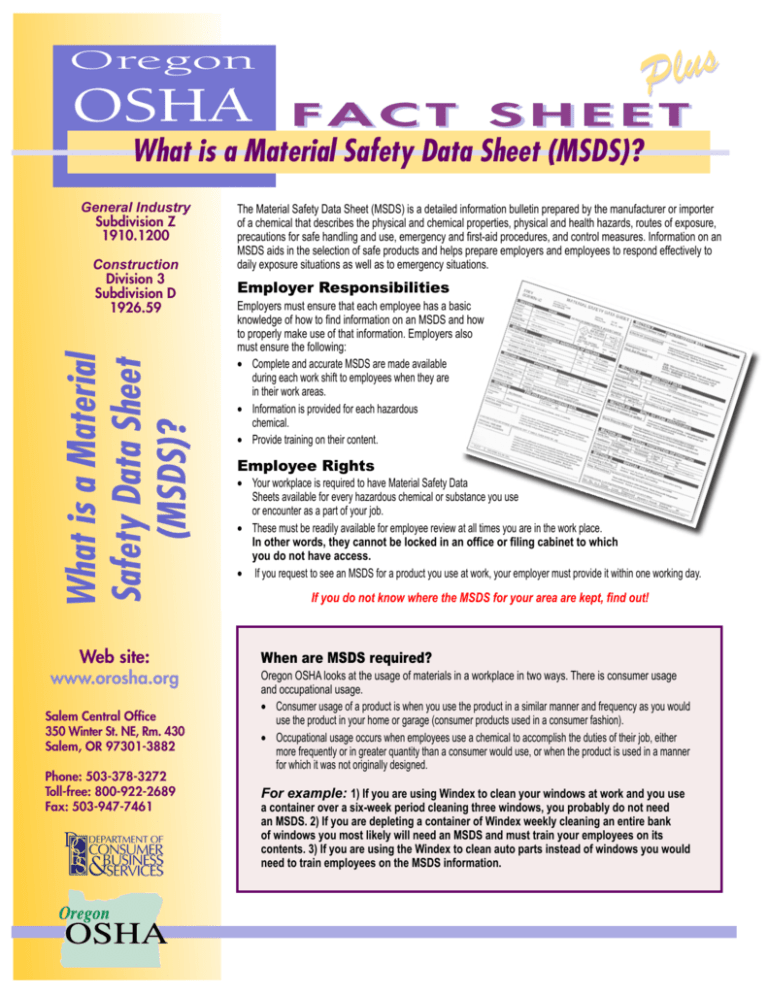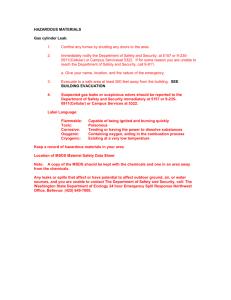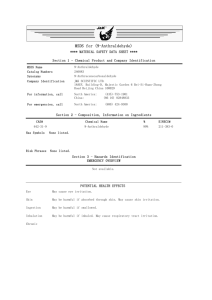What is a Material Safety Data Sheet
advertisement

s u l P Oregon OSHA F FA AC CT T S SH HE EE ET T What is a Material Safety Data Sheet (MSDS)? General Industry Subdivision Z 1910.1200 What is a Material Safety Data Sheet (MSDS)? Construction Division 3 Subdivision D 1926.59 Web site: www.orosha.org Salem Central Office 350 Winter St. NE, Rm. 430 Salem, OR 97301-3882 Phone: 503-378-3272 Toll-free: 800-922-2689 Fax: 503-947-7461 The Material Safety Data Sheet (MSDS) is a detailed information bulletin prepared by the manufacturer or importer of a chemical that describes the physical and chemical properties, physical and health hazards, routes of exposure, precautions for safe handling and use, emergency and first-aid procedures, and control measures. Information on an MSDS aids in the selection of safe products and helps prepare employers and employees to respond effectively to daily exposure situations as well as to emergency situations. Employer Responsibilities Employers must ensure that each employee has a basic knowledge of how to find information on an MSDS and how to properly make use of that information. Employers also must ensure the following: • Complete and accurate MSDS are made available during each work shift to employees when they are in their work areas. • Information is provided for each hazardous chemical. • Provide training on their content. Employee Rights • Your workplace is required to have Material Safety Data Sheets available for every hazardous chemical or substance you use or encounter as a part of your job. • These must be readily available for employee review at all times you are in the work place. In other words, they cannot be locked in an office or filing cabinet to which you do not have access. • If you request to see an MSDS for a product you use at work, your employer must provide it within one working day. If you do not know where the MSDS for your area are kept, find out! When are MSDS required? Oregon OSHA looks at the usage of materials in a workplace in two ways. There is consumer usage and occupational usage. • Consumer usage of a product is when you use the product in a similar manner and frequency as you would use the product in your home or garage (consumer products used in a consumer fashion). • Occupational usage occurs when employees use a chemical to accomplish the duties of their job, either more frequently or in greater quantity than a consumer would use, or when the product is used in a manner for which it was not originally designed. For example: 1) If you are using Windex to clean your windows at work and you use a container over a six-week period cleaning three windows, you probably do not need an MSDS. 2) If you are depleting a container of Windex weekly cleaning an entire bank of windows you most likely will need an MSDS and must train your employees on its contents. 3) If you are using the Windex to clean auto parts instead of windows you would need to train employees on the MSDS information. What is a Material Safety Data Sheet (MSDS)? continued Where do employers obtain MSDS forms? Chemical manufacturers or importers provide MSDS assessing the hazards of chemicals with the first shipment of any hazardous chemical product which they produce or import, and upon request. MSDSs may also be obtained from the distributors that sell the materials or from resources found on the Internet. How are MSDS used? Additional questions commonly asked about MSDS forms: : Do I need a separate MSDS for each color of paint I use? Q A : How long do I have to keep MSDS forms in file and where in the rules do I find information on them? : It depends. If you are using paints that are not similar in nature you might be required to have a MSDS for each type of paint. For example, if you are using an oil-based paint the ingredients will be different than if you are using a latex paint and you might need multiple MSDS forms. If your paints are produced by different manufacturers, if you are using a lead-based paint or if the listed ingredients are different for each paint you might need multiple MSDS forms. Employers use the MSDSs to provide their employees that are exposed to hazardous chemicals with effective information and training. Employees must be trained on the physical and health hazards of the chemicals in the workplace, the measures they can take to protect themselves, and emergency procedures for cleaning up a spill or release of chemicals. What information is required on an MSDS? MSDS must be written in English and contain the following information: 1. Chemical Identity: Name of the product including the common name if one exists 2. Manufacturer’s Information: Name, address, phone number, and emergency phone number of the manufacturer 3. Hazardous Ingredients/Identity Information: List of hazardous chemicals. Depending on the state, the list may contain all chemicals even if they are not hazardous, or only those chemicals that have OSHA standards. Since chemicals are often known by different names, all common (trade) names should be listed. The OSHA Permissible Exposure Limit (PEL) for each hazardous ingredient must be listed. 4. Physical/Chemical Characteristics: Boiling point, vapor pressure and density, melting point, evaporation rate, etc. 5. Fire and Explosion Hazard Data: Flash point, flammability limits, ways to extinguish special firefighting procedures, and unusual fire and explosion hazards. 6. Reactivity Data: How certain materials react with others when mixed or stored together. 7. Health Hazard Data: Health effects (acute=immediate; chronic=longterm), ways the hazard can enter the body (lungs, skin, or mouth), signs and symptoms of exposure, emergency and first-aid procedures, and any medical conditions which are generally recognized as being aggravated by exposure to the chemical. 8. Precautions of Safe Handling and Use: What to do in case materials spill or leak, how to dispose of waste safely, how to handle and store materials in a safe manner, appropriate hygienic practices, and protective measures to be used during the repair and maintenance of contaminated equipment. 9. Control Measures: Ventilation (local, general, etc.), type of respirator/ filter to use, other appropriate engineering controls, work practices or personal protective equipment (PPE) such as gloves, safety glasses, or goggles, face shields, aprons, etc. 10.Primary Routes of Entry: inhalation, absorption, etc. 11.Emergency and First-Aid Procedures: flushing with water, removal to fresh air, etc. : The Hazard Communication Standard in Division 2, Subdivision Z 1910.1200 for General Industry and in Division 3, Subdivision D 1926.59 in Construction requires that employers maintain copies of material safety data sheets for each hazardous chemical used in the workplace. OSHA standard, 1910.1020, Access to employee Exposure and Medical Records defines "employee exposure records" to include material safety data sheets. This standard requires all employee exposure records to be maintained for at least 30 years. An alternative to keeping data sheets, however, is provided for in 1910.1020. Under paragraph (d)(1)(ii)(B) of this standard employers may discard material safety data sheets if some record identifying the substances used, where it was used, and when it was used is retained for at least 30 years. Therefore, an employer may discard the original MSDS and retain only the new data sheet if a record of the original formulation is maintained. Q A : Do mobile worksites need MSDSs? : They are required to have MSDSs but may maintain them off site as long as they are readily available to employees. Readily available means the employer must be able to ensure that the MSDSs are available to employees within that employee’s work shift or may be faxed to an emergency room should an employee have an exposure that requires a visit to a hospital or an emergency care facility. You must have a plan in place for making MSDSs available during those times your offices may be closed or unmanned. The Standards and Technical Resources Section of Oregon OSHA produced this fact sheet to highlight our programs, policies, or standards. The information is from the field staff, research by the technical resources staff, and published materials. We urge readers to consult the actual rules as this fact sheet information is not as detailed. OR-OSHA (2/08) FS-27 Construction Division 3 Subdivision D 1926.59 What is a Material Safety Data Sheet (MSDS)? Q A General Industry Subdivision Z 1910.1200





